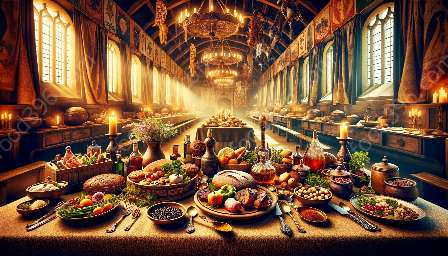The medieval period was a time of significant economic and social change, and food played a crucial role in these transformations. From the growth of trade routes to the development of new culinary techniques, food had a profound impact on the medieval economy and trade. This topic cluster explores the relationship between food, economy, and trade in medieval times, shedding light on the history of medieval cuisine and its influence on the broader culinary landscape.
Medieval Economy and Trade
Medieval Europe was a largely agrarian society, and the economy was primarily based on the production and trade of agricultural products. Food was one of the most valuable commodities, and the medieval economy revolved around the cultivation, distribution, and exchange of food items. The development of trade routes, such as the Silk Road and the Spice Route, facilitated the exchange of foodstuffs and spices across different regions, contributing to the expansion of trade and the growth of the economy.
The establishment of market towns and fairs further stimulated trade and commerce, creating hubs for the exchange of food and other goods. As the economy grew, so did the demand for luxury food items, leading to the rise of luxury trade and the emergence of specialized food markets catering to the elite.
Role of Food in the Economy
Food production played a central role in the medieval economy, with most people engaged in agriculture and food-related activities. The feudal system, which formed the foundation of medieval society, relied heavily on the cultivation of crops and the rearing of livestock to sustain the populace. The surplus food produced by peasant farmers and serfs formed the basis of the economy, providing sustenance for the population and generating surplus for trade.
Food also served as a form of currency and exchange in the medieval economy. Bartering food items, such as grains, meat, and dairy products, was a common practice, and food often functioned as a medium of exchange for other goods and services. The economic value of food extended beyond mere sustenance, as luxury food items and exotic spices became symbols of wealth and status, driving the demand for imported goods and stimulating international trade.
Medieval Cuisine History
The history of medieval cuisine reflects the intersection of culture, trade, and social dynamics. The availability of foodstuffs, coupled with the influence of trade and conquest, shaped the culinary traditions of medieval Europe. The infusion of spices from the Far East, the introduction of new cooking techniques, and the exchange of culinary knowledge through trade routes transformed the flavors and dining habits of medieval society.
Medieval cuisine was characterized by a blend of local and imported ingredients, resulting in a diverse culinary landscape. The medieval kitchen was a place of innovation, where cooks experimented with novel combinations of flavors, textures, and aromas. The distinctive palates of the medieval elite, influenced by the availability of exotic ingredients and the culinary traditions of neighboring regions, gave rise to opulent feasts and banquets that showcased the wealth and sophistication of medieval society.
Cuisine History
The history of cuisine encompasses the evolution of food practices and culinary traditions throughout human civilization. From the hunter-gatherer societies of ancient times to the sophisticated culinary cultures of the modern era, cuisine history reflects the dynamic interplay of cultural exchange, technological advancements, and environmental influences.
Cuisine history provides insights into the diverse ingredients, cooking methods, and dining customs that have shaped human experiences with food. It highlights the role of food in the social, economic, and cultural domains, offering a lens through which to understand the complexities of human society and its relationship with food.

